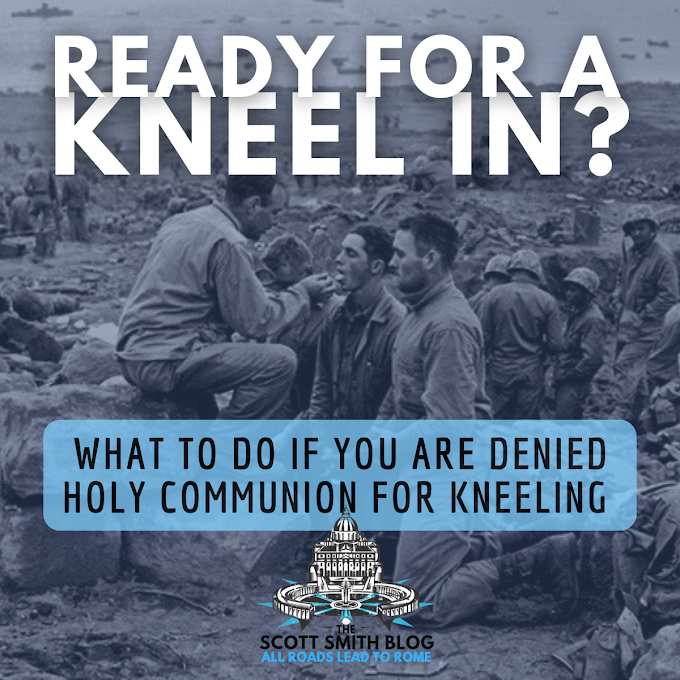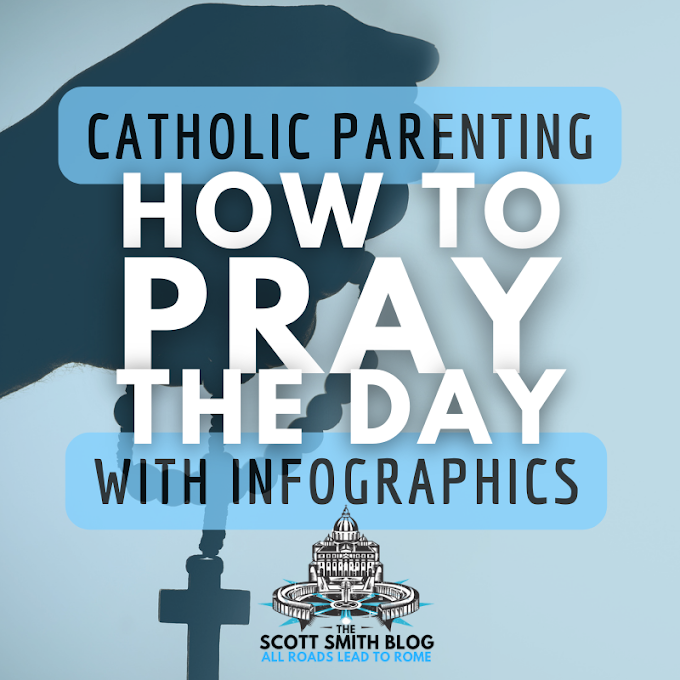Ever wanted a tour of Heaven? Did you know thousands and thousands of buildings across the world depict Moses' own view of heaven?
I was recently asked to take a youth group on a tour of the Temple in Jerusalem. This is a really cool youth group idea by Sarah Stoehr (pictures of the event to be uploaded).
The only problem is ... The Temple in Jerusalem was destroyed over 2,500 years ago. No pictures, obviously. No archaeological evidence because excavations of the Temple Mount are highly restricted. No problem, right?
It really isn't a problem, though. You see, every Catholic Church building is based on the Temple in Jerusalem. Not only that, the Temple and so every Catholic church, too, is based on the Tabernacle of Moses.
So, you might be asking, what's the Tabernacle of Moses based on? The short answer is Heaven ...
Ever wondered where the holy water font came from? The red candle above the Tabernacle? Or even the Tabernacle, itself? In this article, I'm going to show you the origins of all the items found in a Catholic church.
Here are all the parts of a Catholic church that we will go over:
► Outer Court
► Brazier
► Holy Water Font
► Lampstands
► Altar
► Incense
► Veil of the Temple
► Ark of the Covenant
Here's an image of the Tabernacle of Moses to get us started. We'll go over each part of this below:
What stands out in this passage? Here are a few notes:
Of all the details to tell us about, though, why the floor? Think about it. That’s sort of odd, right?
It's like saying this: I visited the White House, dined with the President, but those floors! Let me tell you about the floors ...
Wouldn’t that be an odd detail to focus on? No – not if looking at God’s face would vaporize you. You can look the President, even the Queen, in the eye. They’re just human. Not God. Not in this life, anyway.
So, why did Moses describe the floor in greater detail than God, Himself? Because his head was bowed in reverence. In fact, he was probably laying prostrate on the floor – that sapphire floor – in fear and adoration. That’s why Moses got such a good look at the floor.
Remember the immortal words of Indiana Jones’ Grail Diary. “Only the penitent man will pass. The penitent man kneels before God. Kneel!”
But hold onto this idea of beholding the Face of God. We’ll get to that in a minute.
But what does one “eat” and “drink” at God’s banquet? Maybe the same things we eat at the banquet of the Mass? But I’m getting ahead of myself.
We know what Moses and the men ate and drank because of the food and drink we find later in Moses’ Tabernacle.
This is a very important point: the tabernacle is a representation of what Moses saw at the Theophanic Banquet.
Near the center of the Tabernacle, Moses builds a golden altar with loaves of bread and a flagon wine. The bread is usually translated as the “Bread of the Presence” or the “Showbread” or … one last translation, the “Bread of the Face”. The original Hebrew expression, literally rendered, is "bread of the face".
Do you see where this is going? Bread of the Face of God. More on this in a moment!
Say what?
Moses stays in a cloud of devouring fire for 40 days and 40 nights? Just a little purgatorial fire before re-entering heaven - No big deal, right?
Actually, it was. The Israelites were aware of Moses disappearing into the cloud of fire, and they sort of freaked out. They thought he was dead and gone. So, what's the logical things to do? Fashion an idol out of gold, the Golden Calf, start worshiping it, and throw in an orgy for good measure. Moses is pretty "incensed" when he returns.
In the meantime, though, Moses is receiving instructions from God to build the Tabernacle, the Ark of the Covenant, and even the design for the garments of the priests. This lasts for several chapters of Exodus, chapters 25 through 31. God was able to give a lot of instructions to Moses over those forty days.
[8] And let them make me a sanctuary, that I may dwell in their midst. [9] According to all that I show you concerning the pattern of the tabernacle, and of all its furniture, so you shall make it. (Exodus 25:8-9)
The next several chapters of Exodus describe what will be included in this tabernacle. Here's the breakdown:
► Exodus 25 describes the offerings that will be made in the Tabernacle (Ex 25:1-9), the Ark of the Covenant (Ex 25:10-22), the Table for the Bread of the Presence (Ex 25:23-30), and the Lampstand (Ex 25:31-40).
► Exodus 26 describes the Tabernacle, itself (Ex 26:1-14), the Framework (Ex 26:15-30), and the Curtain (Ex 26:31-37).
► Exodus 27 describes the Altar of Burnt Offering (Ex 27:1-8), the Court and its hangings (Ex 27:9-19), the oil for the Lamp (Ex 27:20-21).
► Exodus 28 describes the Vestments for the Priesthood (Ex 28:1-4), including the Ephod (Ex 28:5-14) and the Breastplate (Ex 28:15-30).
► Exodus 29 describes the Ordination ceremonies for the priests (Ex 29:1-37), which is the longest single section, and the daily offerings (Ex 29:38-46).
► Exodus 30 describes the Altar of Incense (Ex 30:1-10), the Tithe (Ex 30:11-16), the Bronze Basin (Ex 30:17-21), and the Anointing Oil and Incense (Ex 30:22-38).
Stay tuned for PART TWO:
Ever wondered where the Holy Font came from? Or why St. Peter asks Jesus to wash, not just his feet, but his hands and his head, as well? Peter is making a very specific reference to ... the Tabernacle!
I was recently asked to take a youth group on a tour of the Temple in Jerusalem. This is a really cool youth group idea by Sarah Stoehr (pictures of the event to be uploaded).
The only problem is ... The Temple in Jerusalem was destroyed over 2,500 years ago. No pictures, obviously. No archaeological evidence because excavations of the Temple Mount are highly restricted. No problem, right?
It really isn't a problem, though. You see, every Catholic Church building is based on the Temple in Jerusalem. Not only that, the Temple and so every Catholic church, too, is based on the Tabernacle of Moses.
So, you might be asking, what's the Tabernacle of Moses based on? The short answer is Heaven ...
Ever wondered where the holy water font came from? The red candle above the Tabernacle? Or even the Tabernacle, itself? In this article, I'm going to show you the origins of all the items found in a Catholic church.
Here are all the parts of a Catholic church that we will go over:
► Outer Court
► Brazier
► Holy Water Font
► Lampstands
► Altar
► Incense
► Veil of the Temple
► Ark of the Covenant
Here's an image of the Tabernacle of Moses to get us started. We'll go over each part of this below:
First, a little background on the Tabernacle of Moses.
Moses Sees Heaven: The Theophanic Banquet
The Lord has told Moses to come up the mountain. Before Moses leaves, he builds an altar, offers burnt offerings and peace offerings, and throws the blood of the sacrifices upon the altar, calling it the "Blood of the Covenant". [Note: can you guess the only other time that the phrase "blood of the covenant" is used in the Bible? ... During the Last Supper!]
Then, the following happens:
Then, the following happens:
[9] Then Moses and Aaron, Nadab, and Abi′hu, and seventy of the elders of Israel went up, [10] and they saw the God of Israel; and there was under his feet as it were a pavement of sapphire stone, like the very heaven for clearness. [11] And he did not lay his hand on the chief men of the people of Israel; they beheld God, and ate and drank. (Exodus 24:9-11)
(1) Moses really admired that floor, right? That’s, like, all he could talk about. What gives?
Note the observation about the color of the floor. It was a “pavement of sapphire stone, like the very heaven for clearness.” The floor is as blue as the heavens themselves on a clear blue day.Of all the details to tell us about, though, why the floor? Think about it. That’s sort of odd, right?
It's like saying this: I visited the White House, dined with the President, but those floors! Let me tell you about the floors ...
Wouldn’t that be an odd detail to focus on? No – not if looking at God’s face would vaporize you. You can look the President, even the Queen, in the eye. They’re just human. Not God. Not in this life, anyway.
So, why did Moses describe the floor in greater detail than God, Himself? Because his head was bowed in reverence. In fact, he was probably laying prostrate on the floor – that sapphire floor – in fear and adoration. That’s why Moses got such a good look at the floor.
 |
| Pope Francis lies prostrate before the high altar at St. Peter's |
Remember the immortal words of Indiana Jones’ Grail Diary. “Only the penitent man will pass. The penitent man kneels before God. Kneel!”
But hold onto this idea of beholding the Face of God. We’ll get to that in a minute.
(2) “They beheld God, and ate and drank.” – What does one eat and drink with God?
Now, we get to why this is called a “Theophanic Banquet.” It’s a banquet because they eat and drink. It’s a theophany, because they “beheld” God. The martyrs, like Saint Stephen, are often described as having theophanies at the moment of their deaths. They see God welcoming them home. What a beautiful idea!But what does one “eat” and “drink” at God’s banquet? Maybe the same things we eat at the banquet of the Mass? But I’m getting ahead of myself.
We know what Moses and the men ate and drank because of the food and drink we find later in Moses’ Tabernacle.
This is a very important point: the tabernacle is a representation of what Moses saw at the Theophanic Banquet.
Near the center of the Tabernacle, Moses builds a golden altar with loaves of bread and a flagon wine. The bread is usually translated as the “Bread of the Presence” or the “Showbread” or … one last translation, the “Bread of the Face”. The original Hebrew expression, literally rendered, is "bread of the face".
Do you see where this is going? Bread of the Face of God. More on this in a moment!
God Gives Moses the Blueprints
At the end of Exodus 24, God calls Moses back to the mountaintop. Moses enters the Glory Cloud, the Shekinah, which had settled atop the mountain like a "devouring fire." Moses enters the cloud of fire and remains with God for "forty days and forty nights."Say what?
Moses stays in a cloud of devouring fire for 40 days and 40 nights? Just a little purgatorial fire before re-entering heaven - No big deal, right?
Actually, it was. The Israelites were aware of Moses disappearing into the cloud of fire, and they sort of freaked out. They thought he was dead and gone. So, what's the logical things to do? Fashion an idol out of gold, the Golden Calf, start worshiping it, and throw in an orgy for good measure. Moses is pretty "incensed" when he returns.
In the meantime, though, Moses is receiving instructions from God to build the Tabernacle, the Ark of the Covenant, and even the design for the garments of the priests. This lasts for several chapters of Exodus, chapters 25 through 31. God was able to give a lot of instructions to Moses over those forty days.
"Let Them Make Me a Sanctuary"
This is how God begins his instructions to Moses:[8] And let them make me a sanctuary, that I may dwell in their midst. [9] According to all that I show you concerning the pattern of the tabernacle, and of all its furniture, so you shall make it. (Exodus 25:8-9)
The next several chapters of Exodus describe what will be included in this tabernacle. Here's the breakdown:
► Exodus 25 describes the offerings that will be made in the Tabernacle (Ex 25:1-9), the Ark of the Covenant (Ex 25:10-22), the Table for the Bread of the Presence (Ex 25:23-30), and the Lampstand (Ex 25:31-40).
► Exodus 26 describes the Tabernacle, itself (Ex 26:1-14), the Framework (Ex 26:15-30), and the Curtain (Ex 26:31-37).
► Exodus 27 describes the Altar of Burnt Offering (Ex 27:1-8), the Court and its hangings (Ex 27:9-19), the oil for the Lamp (Ex 27:20-21).
► Exodus 28 describes the Vestments for the Priesthood (Ex 28:1-4), including the Ephod (Ex 28:5-14) and the Breastplate (Ex 28:15-30).
► Exodus 29 describes the Ordination ceremonies for the priests (Ex 29:1-37), which is the longest single section, and the daily offerings (Ex 29:38-46).
► Exodus 30 describes the Altar of Incense (Ex 30:1-10), the Tithe (Ex 30:11-16), the Bronze Basin (Ex 30:17-21), and the Anointing Oil and Incense (Ex 30:22-38).
Stay tuned for PART TWO:
Ever wondered where the Holy Font came from? Or why St. Peter asks Jesus to wash, not just his feet, but his hands and his head, as well? Peter is making a very specific reference to ... the Tabernacle!















4 Comments
Shalom!
Melissa